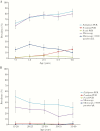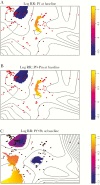Emergence of Nonfalciparum Plasmodium Infection Despite Regular Artemisinin Combination Therapy in an 18-Month Longitudinal Study of Ugandan Children and Their Mothers
- PMID: 29325068
- PMCID: PMC5939692
- DOI: 10.1093/infdis/jix686
Emergence of Nonfalciparum Plasmodium Infection Despite Regular Artemisinin Combination Therapy in an 18-Month Longitudinal Study of Ugandan Children and Their Mothers
Abstract
As part of a longitudinal cohort investigation of intestinal schistosomiasis and malaria in Ugandan children and their mothers on the shorelines of Lakes Victoria and Albert, we documented risk factors and morbidity associated with nonfalciparum Plasmodium infections and the longitudinal dynamics of Plasmodium species in children. Host age, household location, and Plasmodium falciparum infection were strongly associated with nonfalciparum Plasmodium infections, and Plasmodium malariae infection was associated with splenomegaly. Despite regular artemisinin combination therapy treatment, there was a 3-fold rise in P. malariae prevalence, which was not accountable for by increasing age of the child. Worryingly, our findings reveal the consistent emergence of nonfalciparum infections in children, highlighting the complex dynamics underlying multispecies infections here. Given the growing body of evidence that nonfalciparum malaria infections cause significant morbidity, we encourage better surveillance for nonfalciparum Plasmodium infections, particularly in children, with more sensitive DNA detection methods and improved field-based diagnostics.
Figures



References
-
- World Health Organization. 2017 world malaria report. Geneva, Switzerland: World Health Organization, 2017.
Publication types
MeSH terms
Substances
Grants and funding
LinkOut - more resources
Full Text Sources
Other Literature Sources
Medical
Molecular Biology Databases
Research Materials

